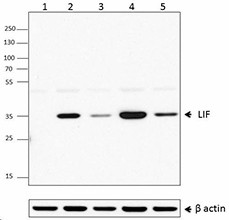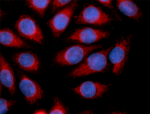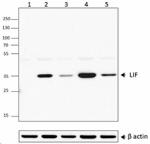- Clone
- M1506B09 (See other available formats)
- Regulatory Status
- RUO
- Other Names
- Leukemia inhibitory factor, HILDA (human interleukin in DA cells), MLPLI (melanoma-derived LPL inhibitor), DIA (differentiation-inducing factor)
- Isotype
- Rat IgG2a, κ

-

Western blot analysis of untreated PBMC (lane 1), PBMC activated with 5 µg/mL of plate-coated anti-CD3 antibody and 2 µg/mL of anti-CD28 antibody for two days (lane 2), untreated IMR-32 cells (lane 3), untreated Raw264.7 (lane 4), and Raw264.7 starved overnight and treated with 1 µg/mL of LPS overnight (lane 5). Anti-LIF antibody (clone M1506B09) and anti-β actin antibody (poly6221) were used, followed by HRP anti-rat IgG antibody (or HRP anti-rabbit IgG (minimal x-reactivity) antibody. -

HeLa cells were fixed with ice cold methanol for six minutes, and blocked with 5% FBS for 30 minutes. Then, the cells were intracellularly stained with 2 µg/mL anti‐LIF (clone M1506B09) antibody followed by Alexa Fluor® 594 conjugated anti‐rat IgG (red) for one hour at room temperature. Nuclei were counterstained with DAPI (blue). The image was captured with a 40X objective.
| Cat # | Size | Price | Quantity Check Availability | ||
|---|---|---|---|---|---|
| 674702 | 100 µg | $229.00 | |||
Leukemia inhibitory factor (LIF) is a pleiotropic cytokine that belongs to the IL-6 receptor family. It binds to a heterodimeric membrane receptor made up of a LIF-specific subunit, gp190, and the subunit gp130. The LIF complex receptor signals though STAT3 and JAK kinases. LIF expression has been observed in various tissues including the thymus, lung, and neuronal tissue. LIF displays diverse biological effects, but is best known for its ability to inhibit the differentiation of embryonic stem cells in mice and contributes to stem cell self-renewal. It is involved in the induction of hematopoietic differentiation in normal and myeloid leukemia cells, as well as the induction of neuronal cell differentiation. It also regulates mesenchymal to epithelial conversion during kidney development, and also may have a role in immune tolerance at the maternal-fetal interface. LIF can be upregulated by pro-inflammatory cytokines such as TNF-α and IL-17. Elevated levels of LIF have been found in cases of rheumatoid arthritis, neural injury, systemic inflammation, and tuberculosis.
Product Details
- Verified Reactivity
- Mouse, Human
- Antibody Type
- Monoclonal
- Host Species
- Rat
- Immunogen
- Recombinant mouse LIF produced in E. coli.
- Formulation
- Phosphate-buffered solution, pH 7.2, containing 0.09% sodium azide.
- Preparation
- The antibody was purified by affinity chromatography.
- Concentration
- 0.5 mg/ml
- Storage & Handling
- The antibody solution should be stored undiluted between 2°C and 8°C.
- Application
-
WB - Quality tested
ICC - Verified - Recommended Usage
-
Each lot of this antibody is quality control tested by Western blotting. For Western blotting, the suggested use of this reagent is 0.25 - 2.0 µg per mL. For immunocytochemistry, a concentration range of 2.0 - 10 μg/ml is recommended. It is recommended that the reagent be titrated for optimal performance for each application.
- RRID
-
AB_2565278 (BioLegend Cat. No. 674702)
Antigen Details
- Structure
- 202 amino acids with a predicted molecular weight of approximately 22 kD.
- Distribution
-
Expressed in the trophectoderm of the developing embryo, activated CD4+ T cells.
- Function
- Inhibits embryonic stem cell differentation and induces the terminal differentiation of myeloid leukemia cells. LIF is upregulated by TNF-α and IL-17. LIF is downregulated by IL-4 and IL-13 in fibroblasts.
- Interaction
- Embryonic stem cells.
- Ligand/Receptor
- LIF receptor complex (gp190 and gp130).
- Cell Type
- T cells, Tregs
- Biology Area
- Cell Biology, Immunology
- Molecular Family
- Cytokines/Chemokines, Growth Factors
- Antigen References
-
1. Moreau JF, et al. 1988. Nature 336:690.
2. Tomida M, et al. FEBS Lett. 334:193.
3. Metcalfe SM. 2011. Genes Immun. 12:157.
4. Voyle RB, et al. 1999. Exp. Cell Res. 249:199.
5. Slaets H, et al. 2010. Trends Mol. Med. 16:493.
6. Souza PP, et al. 2012. Mol. Immunol. 49:601 - Gene ID
- 3976 View all products for this Gene ID
- UniProt
- View information about LIF on UniProt.org
Other Formats
View All LIF Reagents Request Custom Conjugation| Description | Clone | Applications |
|---|---|---|
| Alexa Fluor® 594 anti-LIF | M1506B09 | ICC |
| Purified anti-LIF | M1506B09 | WB,ICC |
Compare Data Across All Formats
This data display is provided for general comparisons between formats.
Your actual data may vary due to variations in samples, target cells, instruments and their settings, staining conditions, and other factors.
If you need assistance with selecting the best format contact our expert technical support team.



